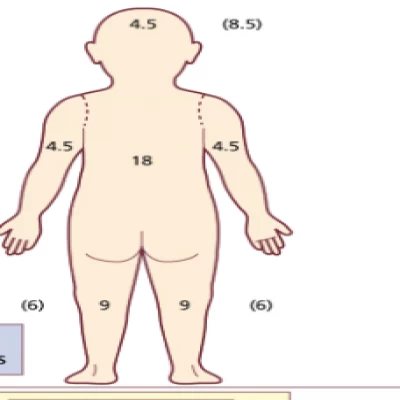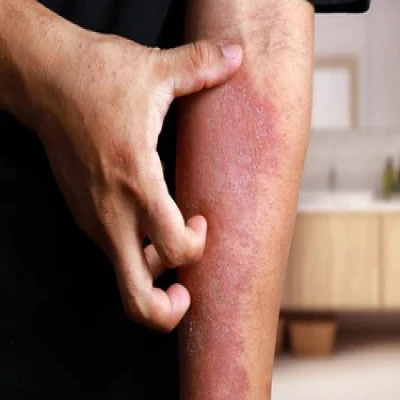مجلات علمية
.webp)
Psoriasis overview
Psoriasis is a skin disease that occurs due to an increase in the rate of cell division to its original weakness, which causes the appearance of dry silvery white scales and red, inflamed patches of skin that appear by removing the scales.[1]
It is classified as a chronic disease and appears at any age, but mainly in the period of childhood and youth less than 35 years, it is not contagious, but it may appear in more than one person in the same family, Symptoms vary from person to person, and symptoms appear sometimes and decrease or disappear at other times.[2]
Symptoms
The appearance and symptoms of psoriasis are focused on specific areas of the body, such as the scalp, knees, elbow and lower back sometimes.[3] The symptoms also differ from one type to another from types of psoriasis
· pustular psoriasis: symptoms are blisters on the palms of the hand and the soles of the feet, which are red and inflamed
· Guttate psoriasis: which is characterized by its simplicity from the previous one, where its symptoms appear in the form of small red dots on the trunk and often appear in childhood associated with tonsillitis
· Inverse psoriasis: appears in the armpits and appears bright
· Erythrodermic psoriasis: which is the most sever type, appears in the form of plaques covering inflamed skin and needs to start treatment immediately.[1]
Causes and pathophysiology
It was believed in the past that psoriasis is a disease in one of the cells that make up the layers of the skin, but recent research has proven that it is a disease of immune origin, where a defect occurs in the immune system that causes the rate of division of cells that make up the skin to increase to a rate of 10 times its first rate, keratin accumulates in the form of sheets (figure 2) and the thickness of the skin under it increases They appear red, and their appearance for the first time is usually associated with a specific event in the patient's life. It may be called a catalyst because it is in one way or another causing a defect in his immune system, so symptoms appear.[4]
Diagnosis
Clinical examination
Psoriasis can be diagnosed through a medical examination and seeing the symptoms, which are plaques on the elbow, scalp, knee and fingertips.[1]
laboratory diagnosis
A sample of the crusted skin is taken and viewed under the microscope to confirm the absence of infection.[1]
Treatment
There is no cure for psoriasis so far, all treatments only improve and reduce symptoms, and their treatment is divided into topical and systemic, and the doctor can determine the appropriate treatment through the rate of spread of psoriasis in the skin, for example, in simple cases less than 10%, topical treatment is the first and best solution It helps to a very large extent to improve symptoms on its own, but in severe cases, more than 20% of the skin has psoriasis, then topical treatment alone is not feasible, so systemic treatment is taken with it until the improvement of cases begins.[5]
Topical treatment
Topical treatments are the most important in mild cases of psoriasis and include
· Steroid creams: which are used as anti-inflammatory and are highly effective and are used in the United States as a basic treatment for psoriasis
· Moisturizing creams: such as soft yellow paraffin or petroleum jelly, which contribute greatly to reducing symptoms such as itching and redness because they moisturize the skin and soften the crusts but remain weak in the treatment of such a disease
· Salicylic acid: which is used topically as a solvent for keratin and removes scales
· anthralin: which is widely used in Europe
Phototherapy and Systemic Treatments
This type of treatment is used by approximately 30% of people with psoriasis, as topical treatments do not help them, so light therapy or systemic treatment is used.[5]
Phototherapy
Using ultraviolet rays, it is effective within two weeks of starting use with coal tar extracts, preferably in case of guttate psoriasis
Systemic treatments
Many systemic medications can be used to treat psoriasis in advanced cases where topical creams do not work, including
· Methotrexate: which stops the production of DNA through the relationship between it and folic acid, and thus reduces the rate of cell division until it reaches its normal value, which is equal to two to three weeks
· etretinate: as it helps to differentiate the appearance and prevents malignant transformations of cells, especially in skin cells
· Systemic steroids: which give high efficacy, but have many side problems, are used in severe cases of psoriasis
References
1. https://www.webmd.com/skin-problems-and-treatments/psoriasis/understanding-psoriasis-basics
2. C. E. Griffiths & J. N. Barker, Pathogenesis and clinical features of psoriasis. The Lancet, 370(9583), 263-271. (2007)
3. https://www.nhs.uk/conditions/psoriasis/
4. J. E. Gudjonsson & J. T. Elder, Psoriasis: epidemiology. Clinics in dermatology, 25(6), 535-546. (2007)
5. M. W. Greaves, & G. D. Weinstein, Treatment of psoriasis. New England Journal of Medicine, 332(9), 581-589. (1995)






